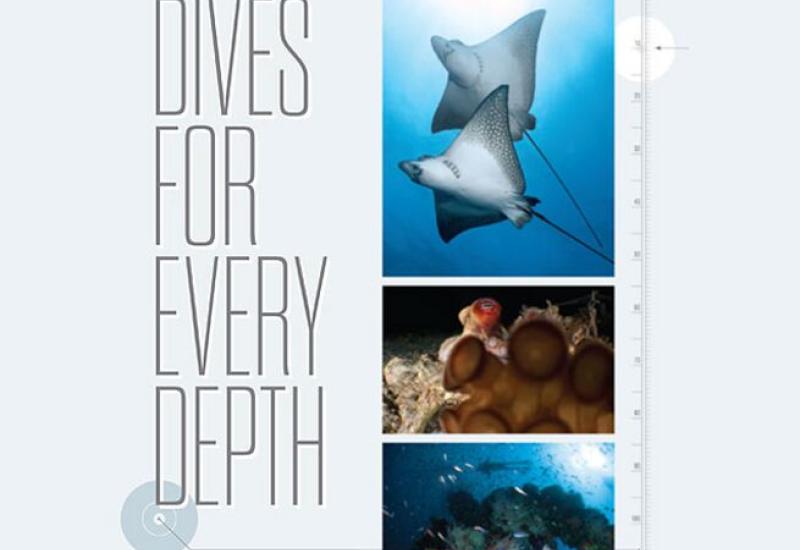Aggressor Fleet Owner’s Trip Report – Galápagos Islands
Sponsored by: Wayne B. Brown, CEO Aggressor Fleet
The Galápagos Islands (official name: Archipelago de Colón) are an archipelago of volcanic islands distributed on both sides of the equator in the Pacific Ocean, more than 550 miles west of continental Ecuador.
The island group consists of 18 main islands, three smaller islands and 107 rocks and islets perched atop the Galápagos hotspot, where the Earth's crust is being melted from below to create volcanoes. The underwater world here is like nowhere else on Earth. Huge schools of Hammerhead sharks and whale sharks, large and curious Galápagos sharks, Galápagos penguins and Mola Mola lure divers from all over.
Our week about the Galápagos Aggressor III began with a few dives by the main islands. The water from the Humboldt current was nearly 20 degrees cooler than that near the far north Wolf and Darwin Islands. On our first full day of diving we started with Punta Carrion off Santa Cruz Island. Playful sea lions frolicked with divers, imitating the release of bubbles from our regulators or tugging on our fins. Cow rays, large schools of Moorish idols, and even groupers greeted us. We also took a land tour of the famous Bartolome Island. A short trek to the island’s summit rewards with expansive views of the surrounding isles and the tall spire seen in the nautical film “Master and Commander.”
Following a great day of diving, we all relaxed after dinner for the 150-mile overnight crossing to Wolf Island. As promised, enormous schools of scalloped hammerheads slowly passed. Wolf is also known for its surprisingly friendly eagle rays and dolphins. Silky sharks gave us something to admire during our safety stops. This is also the only night dive allowed in the national park, located in the relatively shallow, calm bay and loaded with hunting white tip sharks, sea turtles and beautifully-colored hinged beak red shrimp.
On Sunday we made our way Darwin Island to see the famous Darwin’s Arch. While there is only one dive site here, it offers something new and exciting on every dive, like whale shark encounters. When you hear the dive master banging excitingly on his tank, you know something good is on its way!
Tuesday we headed back to the main islands and woke to perfect weather at Fernandina. The water is much cooler here than in the north, which brings in the unique critters. Our photographers snapped as many pictures of red-lipped batfish as they could, as well as the incredible batray found lounging on the bottom. We timed our second dive with the marine iguanas feeding, and watched these amazing creatures munch on green algae.
Then our crew took a zodiac to the island to visit dozens of Galapagos penguins walking, swimming and enjoying the day. Just off the island, we spotted a humpback whale and took the zodiacs out for a closer look. The humpback staying nearby for a while, and even ‘spy hopped’ us to see what was going on!
Tuesday afternoon, we motored over to Isabella in hopes of sighting the large Mola Mola the island is known for. We saw two that came close enough for us to get some great photos, even though the visibility on this day was a lot less than normal. On our second dive here, we found plenty of epaulet sharks, stingrays and more red lipped batfish.
On Wednesday, our last day, we dove Cousin’s rock. I love the underwater topography of this site. With gouged crevices, over hangs on one side and a massive sloping plate on the other, it is covered in turtles, rays, octopus – and if you are looking – loads of nudibranchs and flat worms.
We ended our Galapagos expedition with a visit to the highlands of Santa Cruz to see the famous giant tortoises: This is a natural area where you get to see them in their native habitat and admire their enormous size. A pleasant dinner in a local restaurant in Porto Ayora ended the day, and included LOTS of recapping from the amazing week we shared.
For more information:
Start planning your next trip aboard the Galápagos Aggressor III.
Check out other owner’s trip reports with Wayne Brown aboard the Red Sea Aggressor, Raja Ampat Aggressor and Belize Aggressor III and IV. To dive with the owners, visit www.aggressor.com/dwo.php.










